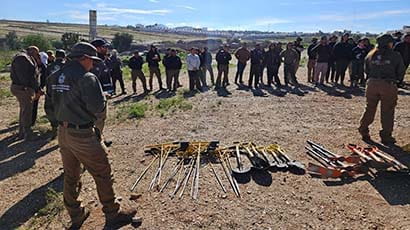Living bricks can generate energy in the home and wean humanity off fossil fuels
The Active Living Infrastructure: Controlled Environment’ (ALICE) research consortium will showcase at The American Association for the Advancement of Science (AAAS) conference today.
ALICE is a collaboration between the University of the West of England, Newcastle University and Translating Nature. The consortium has successfully created a bio-digital communication interface with the ‘living wall’ prototype, which was developed as part of the Living Architecture project that could both revolutionise housing and replace fossil fuels.
The ALICE prototype brings together several ground-breaking threads of bio-digital research. Together it creates a living, breathing, energy-generating microbial system that can simultaneously supply DC power to homes and can, through augmented reality (AR), communicate how productive and ‘healthy it is.
The core Microbial Fuel Cells (MFC) technology, which is the live ‘engine’ driving ALICE, stemmed from work undertaken by Professor Ioannis Ieropoulos, Director of the Bristol Bioenergy Centre at the Bristol Robotics Laboratory in UWE Bristol.
In 2010 he was awarded a five-year EPSRC (Engineering and Physical Sciences Research Council) Career Acceleration Fellowship, which built upon the ground-breaking ‘EcoBot’ research, also supported by EPSRC; many of the findings from the five-year fellowship underpin subsequent projects, such as ALICE.
The base of the ALICE prototype is a partition of ‘living bricks’ which can form entire walls and structures. These living bricks contain microbes that use liquid waste to generate energy, which can then be turned into electricity and clean water.
In order to understand how productive the microbes are, ALICE uses biosensors that record data produced by the microbial electrons; ALICE then fuses biological and digital technologies to converse with the microbes and see how happy they are, and state whether they need to be fed or warmed to generate more bioelectricity.
Self-powered by the microbial fuel cells inside each brick, ALICE can not only be used as a source of household energy but can also transform domestic liquid wastes into clean water fit for reuse.
A digital overlay of the information gathered from ALICE’s conversations with the microbial life in each brick, is then displayed back to the household using AR; currently this is available on a live web server, with animations representing bioelectrochemical reactions.
Professor Ioannis Ieropoulos said: “It is a great privilege to have our ALICE project introduced at The American Association for the Advancement of Science. The excellent work from our partners at Translating Nature and the University of Newcastle has transformed scientifically complex reactions occurring inside MFCs, into live animations with relatable indicators, fed by real-time data. This makes MFCs more acceptable as we move forward with commercialising the technology”.
UWE Bristol’s Vice-Chancellor Professor Steve West said: “Our world is changing fast and the climate crisis and fuel poverty requires us to adapt and innovate our technological solutions to reduce our impact on the worlds fragile ecosystems.
“This project has taken microbial fuel cell technology to the next level. Our challenge now is to capitalise on the science and translate it at pace into our global real-world living. Lives can be transformed and improved globally as we adopt and spread the science and technology advances.”
Professor Dame Lynn Gladden, Executive Chair of the Engineering and Physical Sciences Research Council (EPSRC), part of UKRI, said: “This is a really revolutionary project which could change our residential environment and have a significant impact on how we power our homes in the future. EPSRC is proud to have funded the early investments that led to this work.”
“The results published today are a great example of a collaborative effort in tackling a key issue of the 21st century and should be celebrated as both an achievement for the future of sustainable living and an accomplishment of the science intrinsic to engineering biology.”
Related news

18 December 2025
UWE Bristol professor appointed National Institute for Health and Care Excellence CEO
Jonathan Benger CBE, Professor of Emergency Care at UWE Bristol, has been appointed as the new chief executive officer of the National Institute for Health and Care Excellence (NICE).

17 December 2025
Findings revealed from first UK study into experiences of mothers who are survivors of rape pregnancy
UWE Bristol academics have revealed the findings of the first UK-based study of the experiences of mothers who are survivors of rape pregnancy.

11 December 2025
Social media influencer work is far more demanding than it looks, research finds
A study exploring the mental health impacts of social media influencer work has revealed that life online is far more demanding than it appears.

25 November 2025
UWE Bristol experts join film Q&A exploring music and melodrama
Academics will take part in the Cary Comes Home Festival, with a post-screening Q&A exploring music, melodrama and emotional storytelling in classic cinema.

17 November 2025
Urgent reform needed to support ambulance-delivered end of life care, study finds
More than three quarters (78 per cent) of paramedics sometimes fear doing the wrong thing when caring for people in the last year of life, new research has found.

13 November 2025
Bristol’s screen industry experiences “boom-and-bust cycle” after post-pandemic recovery, new research from UWE Bristol finds
New research from UWE Bristol provides detailed insight into Bristol's screen sector.

13 November 2025
New AI research to revolutionise animal welfare
A UWE Bristol research project will combine behavioural science and AI to create technology that understands not only what animals do, but how they feel.

10 November 2025
Lessons from Low Traffic Neighbourhoods will drive better public engagement, study finds
Lessons from Low Traffic Neighbourhoods have informed a new toolkit to improve engagement with the public on challenging local street issues.

06 November 2025
First-of-its-kind study aims to help more people spend their final days at home
A new study will explore how architectural design could support end-of-life care in domestic settings.

29 October 2025
UWE Bristol academic unveils breakthrough in energy-efficient AI at NATO science forum
Dr Jonathan Lancelot has developed a new form of AI that could transform how intelligent machines operate in space, defence, and remote environments.

15 October 2025
UK food needs radical transformation on scale not seen since Second World War, new report finds
A new report from the Agri-Food for Net Zero Network+ finds urgent action on food is needed if the UK is to reboot its flagging economy, save the NHS billions, ensure national food security, and meet climate commitments.

07 October 2025
Academic playing role in project to find hidden graves in Mexico using drone technology
A UWE Bristol lecturer is playing a part in a project using drone technology to locate concealed graves in Mexico.






